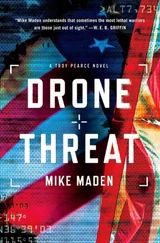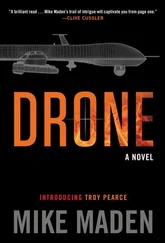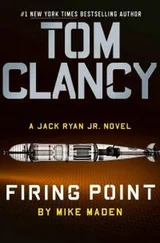“He could be leading us into a trap,” Pearce said. “Let him go.”
An angry finger of smoke rocketed out of the sky. It crashed into the pickup truck in the distance, ripping it apart like a fiery fist.
Pearce glanced at Mann.
“Don’t look at me.”
Pearce pulled out his sat phone and hit the speed dial. “Must have been Ian.” The phone rang. Ian wasn’t picking up.
Base Aérienne Arlit
Arlit, Niger
Lieutenant Beaujolais stood in the air-conditioned ground control center, cheering with the French Air Force Reaper pilot and the rest of the operations crew. He had provided the final visual confirmation the commanding officer required before launching the missile. Beaujolais gladly confirmed The Viking’s identity. The Hellfire had just vaporized Al Rus. The AQS scourge of the Sahara was finally dead. Operation Dress Down Six was a success.
The purchase and deployment of American Reaper drones had already paid off handsomely for the French military, especially now that resources for their Africa operations were dwindling. But this new technology had just proven its value in spades. The ability to loiter for hours, identify suspects, and execute them with the push of a button heralded a new era in French antiterror operations in the region.
Corks popped. The commander poured the champagne himself. They raised glasses and the entire command shouted in unison, “Vive la France!”
 54
54 
Karem Air Force Base
Niamey, Niger
15 May
Judy was still confined to her quarters. She couldn’t sleep. She paced nervously in the cramped little room. She checked her watch again, as if that mattered. She was due to pick up Pearce in the Aviocar in less than twelve hours and she was still locked up in here with a twenty-four-hour armed guard stationed outside her door.
Ian had promised to call her last night but didn’t. She couldn’t stand it anymore. She fingered the copper-colored carabiner latched to her belt loop. The Security Forces guards didn’t think twice about confiscating it. They couldn’t possibly know it fired aerosolized super glue and pepper oil. Pearce had Rao make it for her, since she refused to carry a gun for self-protection. She could easily use it to disable the lone guard at the door, a really nice kid who was kind of sweet on her. But she couldn’t do it, especially to a soldier just doing his duty.
The SF guards had given her cell phone back after her interrogation. Of course, they’d bugged it, or so Judy had to assume. She’d pulled the battery and the SIM card out and stored them. Besides getting tapped, Ian had taught her that a smartphone could also be remotely activated and used for both audio and video surveillance. But the SFs hadn’t taken her analogue aviator watch, which actually wasn’t just a watch. She flipped up the face and tapped the touch screen. It was meant only for extreme emergencies. This felt like one.
Ian answered.
Judy dashed into the bathroom and turned on the shower to mask her voice from the guard outside her door. “Thank God, Ian. Where have you been? You were supposed to call me.”
“Busy, love. What do you need?”
“What do I need? I need you to get me out of here. I’m trapped.”
“I know. I’m working on it. Working on lots of things. Sit tight.”
“What about Troy?”
“Working on that, too. Bye.” Ian ended the call.
“Ian! Ian!”
Judy growled, frustrated. She thought a very, very bad word but couldn’t bring herself to say it. Her dad would have been ashamed if she had.
Malta International Airport,
Luqa, Malta
One of the smallest members of the European Union, Malta was a strategic three-island archipelago south of Sicily, some two hundred miles east of the Tunisian coast, in the heart of the Mediterranean Sea. The Armed Forces of Malta (AFM) was a very small volunteer force comprising land, sea, and air elements whose primary task was defense of the islands and safe-passage guarantees for the high-traffic commercial shipping lanes passing through its waters.
With a minuscule budget and few human resources, the AFM recently turned to drone technologies to enhance its capabilities. With the aid of an EU grant, the AFM engaged the services of Dr. T. J. Ashley, the former head of Drone Command during the Myers administration but now the CEO of her own private consulting firm. With the assistance of Dr. Rao and Pearce Systems, she had put together an air-sea rescue drone system package based on a highly modified Boeing A-160T Hummingbird VTOL aircraft and fitted with four external covered litters, like one of the old M.A.S.H. helicopters, just without a pilot.
Ashley’s improved thirty-five-foot-long A-160X airframe could carry a 2,500-pound payload over 2,200 nautical miles at a speed of up to 165 knots. With a rotor diameter of just six feet, it was perfectly suited to land on flat decks and helipads, where wounded sailors or injured merchant mariners in the Mediterranean Sea could be loaded on—in theory—and transported back to almost any hospital in Europe, even London.
Ashley’s initial field tests were encouraging. She’d managed to fly seven consecutive Hummingbird missions fully loaded with life-sized dummies on missions over five hundred miles without incident. The AFM wanted only a three-hundred-mile mission capability, but Ashley wanted to push the performance envelope as far as possible. The United States Marine Corps had successfully tested the Hummingbird as a supply vehicle over much shorter distances. If human cargo was going to be put at risk, she wanted to be damn sure that the machine was capable of transporting them safely. As a former Navy officer, Ashley knew how important air-sea rescue operations were and she was proud to be pioneering one of the first drone programs that could save sailors’ lives at sea.
Ashley’s short-cropped hair was buffeted by the strong predawn coastal winds, but she didn’t mind. It was going to be another warm day beneath a brilliant blue Maltese sky, and the Hummingbird had just been prepped for its last test mission. If her luck held, she’d be heading back to Texas next week.
“Dr. Ashley?”
Ashley turned around. “Yes?”
“My name is Stella Kang. Ian sent me.”
Aéropostale Station 11
Tamanghasset Province, Southern Algeria
Pearce, Mossa, and the rest of the caravan crested the last of the small dunes. A decrepit air station shimmered in the heat down below them. It looked more like an abandoned Howard Hawks movie set than a failed airport. A two-story-tall cement tower was flanked by two squat buildings, a pump house, and a generator room. A third building, the largest, was the hangar. The three buildings all faced the cracked but serviceable concrete runway and stood on the north side of it. A rusted pulley clutching a shredded halyard tink ed against the flagpole on top of the tower, buffeted by a nearly imperceptible breeze. Sun-bleached painted letters on the dusty hangar wall read “Aéropostale.”
“I wonder if he ever flew here,” Pearce said to himself.
“Who?” Early asked.
“Antoine de Saint-Exupéry.”
“Say again?”
“The writer. You know, The Little Prince ? He flew airmail routes for this outfit between the wars.”
“Sorry, buddy. I skipped the Lit courses. But I can tell you all about my Aunt Bertie’s goiter.”
Читать дальше

 54
54 











